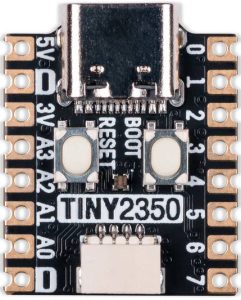2.4GHz comms is through a Raspberry Pi RM2 module – a module that Raspberry Pi has yet to reveal.
Also on-board is 16Mbyte of QSPI flash, 8Mbyte of ram, USB-C and a Qwiic/STEMMA QT I2C interface connector for sensors, a SWD debug connector, reset button boot/user button.
About the development board, called ‘Pico Plus 2 W’, Pimoroni said: “we’ve tried to cram in as much extra functionality as we possibly can whilst keeping to the original Pico footprint to maintain compatibility with existing Pico add-ons.”
Power is required at 3 – 5.5V, and the included 3V3 regulator can output 600mA.
The board measures 53 x 21 x 9mm.
RP2350 has dual Cortex-M33 cores, but can also be booted with RISC-V cores in their place, and hardware security.
“Our MicroPython tests are running up to 2x faster compared to RP2040, and floating point number crunching in C/C++ is up to 20x faster,” said Pimoroni. “The extra on-chip RAM will make a big difference when performing memory intensive operations, such as working with higher resolution displays, and even more can be added thanks to external PSRAM support.”
 ‘Pico Plus 2’ is a version of this board without the radio, and Tiny 2350 (right), also from Pimoroni, is a 23 x 18 x 6mm module with fewer IO connections designed to be built into products.
‘Pico Plus 2’ is a version of this board without the radio, and Tiny 2350 (right), also from Pimoroni, is a 23 x 18 x 6mm module with fewer IO connections designed to be built into products.
All of the boards abover are double-sided, and therefore cannot be surface-mounted using the castellated side pads without a PCB cut-out.

